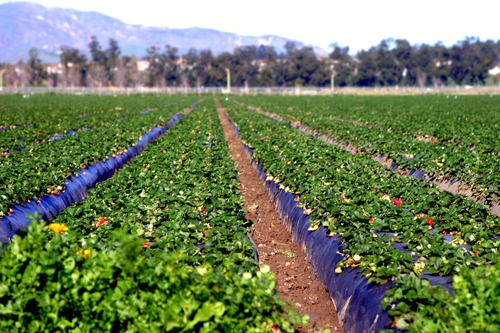
By Ashley Robinson
Since the phaseout of methyl bromide, charcoal rot, caused by the pathogen Macrophomina, has become a growing issue for Florida strawberry growers.
For years, soil fumigation with methyl bromide was the preferred method to manage soilborne pathogens such as Macrophomina. However, because methyl bromide was categorized as a Class I ozone-depleting substance, its production and use have been phased out.

ALTERNATIVE FUMIGANTS
Since the phaseout, researchers have been looking for alternatives to methyl bromide. Fumigants that have been under research include Vapam, KPam, Telone and Pic-Clor 80. The alternative fumigants have shown to work when applied under optimal conditions.
“Soil moisture is really important,” says Natalia Peres, professor of plant pathology at the University of Florida Institute of Food and Agricultural Sciences Gulf Coast Research and Education Center (UF/IFAS GCREC). She recently spoke on the topic of fumigants for soilborne pathogens in strawberries at the Florida Ag Expo.
According to Peres, it is important that the soil isn’t too wet or too dry when applying fumigants. She says fumigating in Florida during the summer months can be difficult due to the increased rainfall, creating unideal conditions for fumigant application.
The main disadvantage with alternative fumigants is their coverage compared to methyl bromide. “Some of those fumigants are applied through the drip tape. They don’t move as well in the soil profile to get to the shoulder of the beds to get a good coverage,” Peres says.
OTHER STRATEGIES
Another strategy Peres suggests for disease prevention is for growers to not reuse their plastic, especially if they have had disease problems in their field.
Management of charcoal rot relies on the reduction of pathogen inoculum in the field. Growers run the risk of the pathogen multiplying when old crowns have been disposed of in the field and the plastic is reused the following planting season. By removing the crop residue from the field at the end of the season, growers can reduce the amount of time inoculum has the potential to build up, explains Peres.
In addition, she says selecting cultivars with some resistance can be a useful strategy to prevent against diseases. Strawberry cultivars researchers have discovered that have the highest resistance to Macrophomina are the Sensation and Brilliance varieties, developed at the UF/IFAS GCREC. “They’re not completely immune by any means,” says Peres. However, when combined with fumigants, having the extra resistance can help.









